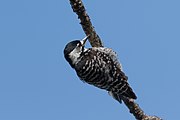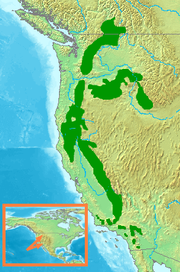
Picinae containing the true woodpeckers is one of four subfamilies that make up the woodpecker family Picidae. True woodpeckers are found over much of the world, but do not occur in Madagascar or Australasia.

The hairy woodpecker is a medium-sized woodpecker that is found over a large area of North America. It is approximately 250 mm (9.8 in) in length with a 380 mm (15 in) wingspan. With an estimated population in 2020 of almost nine million individuals, the hairy woodpecker is listed by the IUCN as a species of least concern. Some nomenclature authorities, such as the eBird/Clements checklist, place this species in the genus Dryobates.

Chrysocolaptes is a genus of birds in the woodpecker family Picidae that are found in South and Southeast Asia.

Dinopium is a genus of birds in the woodpecker family Picidae. The species are found in South and Southeast Asia.

Campephilus is a genus of large American woodpeckers in the family Picidae.

Dryocopus is a genus of large powerful woodpeckers, typically 35–45 cm in length. It has representatives in North and South America, Europe, and Asia; some South American species are endangered. It was believed to be closely related to the American genus Campephilus, but it is part of a different lineage of woodpeckers altogether

Picoides is a genus of woodpeckers that are native to Eurasia and North America, commonly known as three-toed woodpeckers.

Melanerpes is a genus of woodpeckers of the family Picidae found in the Americas. The 24 members of the genus are mostly colourful birds, conspicuously barred in black and white, with some red and yellow.

Colaptes is a genus of birds in the woodpecker family Picidae. The 14 species are found across the Americas.

Dendrocopos is a widespread genus of woodpeckers from Asia, Europe and Northern Africa. The species range from the Philippines to the British Isles.

Blythipicus is a genus of birds in the woodpecker family Picidae that are found in Southeast Asia.

Dendropicos is a genus of woodpeckers in the family Picidae. They are small woodpeckers that are native to the sub-Saharan woodlands and forests.

Meiglyptes is a genus of Southeast Asian birds in the woodpecker family Picidae.

The olive woodpecker is a species of bird in the woodpecker family Picidae.

Mulleripicus is a genus of birds in the woodpecker family Picidae. They are found in South and Southeast Asia. The genus forms part of the woodpecker subfamily Picinae and has a sister relationship to the genus Dryocopus whose species are widely distributed in Eurasia and the Americas.

Piculus is a genus of birds in the woodpecker family Picidae that are found in Central and South America.

Chrysophlegma is a genus of birds in the woodpeckers family Picidae. These species, found in South and Southeast Asia, were all previously assigned to the genus Picus.

Yungipicus is a genus of woodpeckers in the family Picidae native to Asia. The species in this genus were previously placed in the genus Dendrocopos.

Dendrocoptes is a genus of woodpeckers in the native to Eurasia.

Chloropicus is a genus of birds in the woodpecker family Picidae that are native to Sub-Saharan Africa.










































